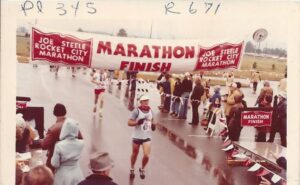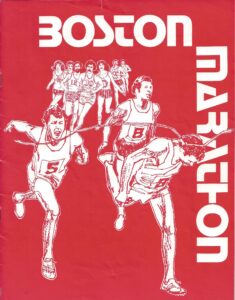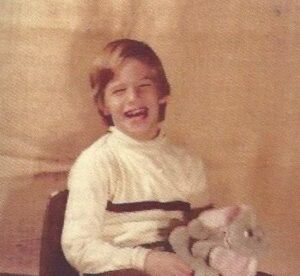I didn’t start jogging for fitness until my late 30s. In high school and college football I was not known as a particularly speedy runner. However, I now found that by increasing my long runs and as indicated by my times in six-mile races, I was becoming competitive with other runners in my age group.
The ultimate achievement for a long-distance runner is competing in the country’s oldest marathon, the Boston Marathon. It was first held in 1897 to commemorate the start of the Revolutionary War.
“The Boston” as all runners refer to it, is a prestigious invitational event that requires qualification in order to enter. I’d never entered a 26.2 mile race before and as a 40-year-old in 1979, I would need to run a previous marathon in less than 3 hours and 30 minutes in order to qualify for Boston. That’s a breathless 8-minute-per mile pace and I thought…I could do it. The Boston is held on the third Monday in April. Therefore, in December, I traveled to Huntsville, Alabama, to run the Rocket City Marathon to attempt the qualifying time. I finished in 3 Hours, 28 minutes, 28 seconds. Whew, I was Boston bound.

The winter of 1979 was brutal in Indiana with several feet of snowfall. Training for Boston meant I needed to put in serious road work mileage prior to April. Some mornings the only plowed roadways I could find were the runways at our local airport. Air traffic was fortunately light on those days.
The Boston Marathon finishes at the Prudential Center in Boston and starts in Hopkinton, Mass., a town 26 miles west of Bean town. There was a field of 7,800 runners that year, all staged at the starting line according to their qualification time. I was a half mile back from the front runners.
It was cool that April morning in Massachusetts and most runners waited for the start wearing jackets, mittens, and knit hats. From my back-in-the-pack position, I couldn’t hear the firing of the starting gun, but helicopters above the starting line began to circle so I knew the race had begun. Jogging a few steps into the congestion, I then had to wait for an opening before being able to run again. It took me seven minutes to actually cross the starting line and it was five miles before I was able to freely run my marathon pace.

All the warm-up attire runners had worn before the race was now found discarded along the side of the road. Those $100-dollar Adidas and Nike nylon pants and jackets were now available to any for the pickings.
We passed through several small towns and villages on the route to Boston. Ashland, Framingham, Natick, and the town of Wellesley had thousands of spectators lining the streets. How was it that I was hearing, “Hey, Jim Stark. You’re looking good. Go Indiana”? Then I learned the bystanders had marathon programs that listed all 7,800 runners by name, hometown, and their running number. Wellesley College with its hundreds of co-eds was particularly motivating and I must confess to sprinting past that campus much faster than my planned pace. Pant, pant!

One of the celebrity runners in the race was the 70-year-old Walt Stack, a brick mason from San Francisco, who ran each year. He claimed the secret to his fitness was beer, and he ran with a can in his hand generously replenished by fans along the route. I caught up with Walt at the 16-mile marker. How incredible it was to hear the thousands cheering his name and how humbling it was to realize this 70-year-old had out-run me for 16 miles.
Heartbreak Hill is really three hills, and they appear at the 20-mile mark on the marathon course. Twenty miles is significant because it’s at that point a runner’s body runs out of glycogen (stored energy) forcing the athlete to slow his pace, sometimes to a walk.
At the top of the third hill stands an Irish cop, reportedly stationed there for years, giving encouragement to struggling participants. “Looking fine, my boy. Just a short distance to go. God’s speed to you, Laddie. You can do it.”
I finished the marathon in Three hours and forty-one minutes, thirteen minutes slower than my Huntsville time. But if you subtract the slow start and the congestion of those first five miles, I guess it wasn’t so bad.
I had brought my family with me to Boston, including my three sons, ages thirteen, eleven, and seven. Boston Marathon day (Patriot’s Day)—the third Monday in April—is a holiday in Massachusetts, but not in other states. I needed to get the boys back to school, so planned to drive all night back to Indiana immediately after the race. I had a van and the boys could stretch out and sleep on the floor in back.
Although physically tired after the race, I was pumped up emotionally from all the festivity and would drive the initial portion of our 950-mile trip.
We stopped for gas at the Delaware Water Gap, New Jersey, and that’s when it happened. Brian, the youngest, our seven-year-old, got out of the car to use the rest room and we drove off and left him. Oh no! Details of that incident were written about in a blog article I posted on January 3, 2019, titled “Where’s Brian.”

Although we didn’t realize he was missing for several hours—just assumed he was asleep in the back of the van—he was rescued almost immediately by a couple in a arriving car and a New Jersey State Trooper who pulled into the gas station moments after we departed. Not knowing if we went east or west, the couple and the officer didn’t give chase, assuming we would realize our son was missing and return shortly.
To make a long story short, the trooper took Brian to the police barracks and put out an all-points bulletin to be on the lookout for a white van with Ohio license plates. Brian had properly recited his street address and town—4320 North Washington Street, Columbus—but apparently wasn’t clear about the Indiana part.
It was 2:30 AM somewhere in Pennsylvania on our next fuel stop when we discovered our son was missing. A call to the state police assured us Brian was safe and being cared for back in New Jersey. My wife didn’t think shipping him home via UPS was a good idea—just kidding, sick joke—so we turned around and made a four-hour drive back to New Jersey.
All’s well that ends well, and Brian has considered that experience to be the catalyst for many of his adventurous pursuits. In addition to having run across the United States in 1998, in 2011 Brian was challenged by the Nevada State Parks to run 500-miles across the state on trails setting a record for the feat. He was interviewed by a Reno television station with just 50-miles to go. His mother and I had traveled to Nevada to witness his finish and were standing behind the TV cameras during the interview. The reporter asked Brian, “What makes someone run such incredible distances?”
Brian replied, “When I was little, my mom and dad drove off and left me in New Jersey and I’ve been running ever since.” A mournful cry by Brian’s mom was clearly heard behind the camera.
Awesome story!!! I guess the kids didn’t make it to school on time.
I remember this story. Still impressive to read again. Thanks for the chance to do so.
Jim, another great story, an experience Brian will never forget I am sure. However, my hero of the event is Walt Stack. Anybody that can run 16 miles while drinking Samuel Adams definitely gets my vote. Keep them coming. Thanks.
I remember this story vividly from when you told it to Sally and me during one of our annual get togethers. Funny to hear after the fact; no so funny at the time. Brian didn’t too badly scarred by the incident.
What a great line from Brian.
Jim, you may not remember, but it was a few weeks after all this that you hired me ( May 8, 1979) and you shared the story with Brenda and me over dinner, or something. I had come from a less sedative job and was looking for a way to stay in shape. You suggested running. Well, I’ve never run a marathon, but I’m still running to this day – not many miles, a little slower, I’m sure, but thankful to you for that suggestion. Thanks for the story. John
Great pictures and a memorable story, for sure! Love the newspaper clipping!